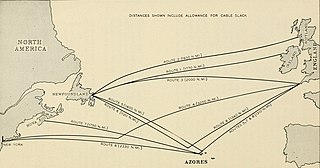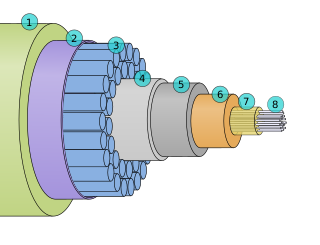Related Research Articles
Telecommunications in Kuwait provides information about the telephone, Internet, radio, and television infrastructure in Kuwait.

TAT-1 was the first submarine transatlantic telephone cable system. It was laid between Kerrera, Oban, Scotland and Clarenville, Newfoundland. Two cables were laid between 1955 and 1956 with one cable for each direction. It was inaugurated on September 25, 1956. The cable was able to carry 35 simultaneous telephone calls. A 36th channel was used to carry up to 22 telegraph lines.
TAT-6 was the sixth transatlantic telephone cable. It was in operation from 1976 to 1994, with a bandwidth of 12MHz between Green Hill and Saint-Hilaire-de-Riez, Vendée, (France).
TAT-8 was the 8th transatlantic communications cable and first transatlantic fiber-optic cable, carrying 280 Mbit/s between the United States, United Kingdom and France. It was constructed in 1988 by a consortium of companies led by AT&T Corporation, France Télécom, and British Telecom. AT&T Bell Laboratories developed the technologies used in the cable. The system was made possible by opto-electric-opto regenerators acting as repeaters with advantages over the electrical repeaters of former cables. They were less costly and could be at greater spacing with less need for associated hardware and software. It was able to serve the three countries with a single transatlantic crossing with the use of an innovative branching unit located underwater on the continental shelf off the coast of Great Britain. The cable lands in Tuckerton, New Jersey, USA, Widemouth Bay, England, UK, and Penmarch, France.

A submarine communications cable is a cable laid on the seabed between land-based stations to carry telecommunication signals across stretches of ocean and sea. The first submarine communications cables were laid beginning in the 1850s and carried telegraphy traffic, establishing the first instant telecommunications links between continents, such as the first transatlantic telegraph cable which became operational on 16 August 1858.
Hybrid fiber-coaxial (HFC) is a broadband telecommunications network that combines optical fiber and coaxial cable. It has been commonly employed globally by cable television operators since the early 1990s.

A cable layer or cable ship is a deep-sea vessel designed and used to lay underwater cables for telecommunications, for electric power transmission, military, or other purposes. Cable ships are distinguished by large cable sheaves for guiding cable over bow or stern or both. Bow sheaves, some very large, were characteristic of all cable ships in the past, but newer ships are tending toward having stern sheaves only, as seen in the photo of CS Cable Innovator at the Port of Astoria on this page. The names of cable ships are often preceded by "C.S." as in CS Long Lines.

Hibernia Networks, alternately known as Hibernia Atlantic, was a privately held, US-owned provider of telecommunication services. It operated global network routes on self-healing rings in North America, Europe and Asia including submarine communications cable systems in the North Atlantic Ocean which connected Canada, the United States, the Republic of Ireland, the United Kingdom and mainland Europe. Hibernia managed cable landing stations in Dublin, Republic of Ireland; Coleraine, Northern Ireland; Southport, England; Halifax, Canada; Lynn, Massachusetts, United States.

Fiber to the x or fiber in the loop is a generic term for any broadband network architecture using optical fiber to provide all or part of the local loop used for last mile telecommunications. As fiber optic cables are able to carry much more data than copper cables, especially over long distances, copper telephone networks built in the 20th century are being replaced by fiber.
Optical networking is a means of communication that uses signals encoded in light to transmit information in various types of telecommunications networks. These include limited range local-area networks (LAN) or wide area networks (WANs), which cross metropolitan and regional areas as well as long-distance national, international and transoceanic networks. It is a form of optical communication that relies on optical amplifiers, lasers or LEDs and wavelength-division multiplexing (WDM) to transmit large quantities of data, generally across fiber-optic cables. Because it is capable of achieving extremely high bandwidth, it is an enabling technology for the Internet and telecommunication networks that transmit the vast majority of all human and machine-to-machine information.

Fiber-optic communication is a method of transmitting information from one place to another by sending pulses of infrared or visible light through an optical fiber. The light is a form of carrier wave that is modulated to carry information. Fiber is preferred over electrical cabling when high bandwidth, long distance, or immunity to electromagnetic interference is required. This type of communication can transmit voice, video, and telemetry through local area networks or across long distances.

Telecommunications engineering is a subfield of electronics engineering which seeks to design and devise systems of communication at a distance. The work ranges from basic circuit design to strategic mass developments. A telecommunication engineer is responsible for designing and overseeing the installation of telecommunications equipment and facilities, such as complex electronic switching systems, and other plain old telephone service facilities, optical fiber cabling, IP networks, and microwave transmission systems. Telecommunications engineering also overlaps with broadcast engineering.
SHEFA-2 is an undersea communication cable linking the Faroe Islands to mainland Scotland via the Northern Isles. It is named after the route on which it is being deployed (SHEtland-FAroes) and succeeds an earlier cable called SHEFA-1 on the same route.
UK-Belgium 5 was a submarine communications cable linking the United Kingdom and Belgium. It was the first international undersea cable system to use optical fibres rather than coaxial cable.
Saint Helena, Ascension and Tristan da Cunha is a British Overseas Territory in the South Atlantic, consisting of the island of Saint Helena, Ascension Island and the archipelago of Tristan da Cunha including Gough Island. Their communications provision includes dedicated radio and television stations, and telecommunications infrastructure.
SAex is a proposed submarine communications cable linking South Africa to the United States with branches to Namibia, Saint Helena, and Brazil.

MAREA is a 6,605 km long transatlantic communications cable connecting the United States with Spain. Owned and funded by Microsoft and Facebook, but constructed and operated by Telxius, a subsidiary of the Spanish telecom company Telefónica, it is the "highest-capacity submarine cable in the world" with a system design capacity of 200 terabits per second as of 2019.
Hibernia Express is a submarine communications cable system which was privately owned by Hibernia Networks linking Canada, Ireland, and the UK. Hibernia Express is now owned by telecommunications provider GTT Communications, Inc. after their acquisition of Hibernia Networks. At 58.95ms of latency, the cable is currently the lowest latency fiber optic route between the NY4 data center in Secaucus, New Jersey and London.
Grace Hopper is a private transatlantic communications cable that connects the United States of America with the UK (Bude) and Spain (Bilbao). It was announced by Google in 2020 and scheduled to go live in 2022. The US to UK (Bude) leg went live on 27 September 2022.
References
- ↑ Guarnieri, M. (March 2014). "The Conquest of the Atlantic". IEEE Industrial Electronics Magazine. 8 (1): 53–55/67. doi:10.1109/MIE.2014.2299492.
- ↑ Elmore, Bart. "January 2017: From the Transatlantic Telephone to the iPhone". Origins. Ohio State University. Retrieved May 28, 2021.
- ↑ Short-Wave System for Transatlantic Telephony, by Polkinghorn and Schlaack BSTJ, 1935
- ↑ "Being First Telephone Cable to Connect Hemispheres". Popular Mechanics, March 1954, p. 114.
- ↑ "Building Networks for High-Speed Stock Trading - WSJ.com". Online.wsj.com. October 9, 2011. Retrieved September 18, 2013.
- 1 2 3 "The $300m cable that will save traders milliseconds". The Daily Telegraph. London. September 11, 2011. Archived from the original on September 11, 2011. Retrieved September 18, 2013.
- ↑ "Angola Cables to build the world's first submarine cable across the South Atlantic: Press Releases - NEC".
- ↑ "16Tbit/s SAEx cable deal signed".
- ↑ "Hibernia Offers Cross-Atlantic 40G". Light Reading. August 13, 2009.
- ↑ "Submarine Cable Actions Taken PN". FCC. October 4, 2012.
- ↑ Sawers, Paul (April 24, 2019). "How Google is building its huge subsea cable infrastructure". VentureBeat. Archived from the original on April 25, 2019. Retrieved April 26, 2019.
- ↑ Li, Abner (April 5, 2019). "Google's Dunant trans-Atlantic cable will deliver record-breaking capacity w/ first use of SDM tech". 9to5Google . Archived from the original on April 25, 2019. Retrieved April 25, 2019.
- ↑ Tanwen Dawn-Hiscox (January 16, 2018). "Aqua Comms plans Havfrue, transatlantic cable network funded by Facebook, Google". Data Center Dynamics.
- ↑ Koley, Vikash (July 28, 2020). "Announcing the Grace Hopper subsea cable, linking the U.S., U.K. and Spain". Google Cloud.
- ↑ Lardinois, Frederick (July 28, 2020). "Google is building a new private subsea cable between Europe and the US". TechCrunch.
- ↑ "Orange landing the transatlantic Amitié cable". TotalTele. February 8, 2021.